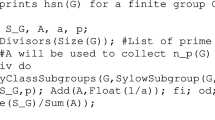Abstract
The Gruenberg–Kegel graph (prime graph) \(\Gamma(G)\) of a finite group \(G\) is a graph in which the vertices are the prime divisors of the order of \(G\) and two distinct vertices \(p\) and \(q\) are adjacent if and only if \(G\) contains an element of order \(pq\). The problem of recognition of finite groups by their Gruenberg–Kegel graph is of great interest in finite group theory. For a finite group \(G\), \(h_{\Gamma}(G)\) denotes the number of all pairwise nonisomorphic finite groups \(H\) such that \(\Gamma(H)=\Gamma(G)\) (if the set of such groups \(H\) is infinite, then \(h_{\Gamma}(G)=\infty\)). A group \(G\) is called \(n\)-recognizable by its Gruenberg–Kegel graph if \(h_{\Gamma}(G)=n<\infty\), recognizable by its Gruenberg–Kegel graph if \(h_{\Gamma}(G)=1\), and unrecognizable by its Gruenberg–Kegel graph if \(h_{\Gamma}(G)=\infty\). We say that the problem of recognition by the Gruenberg–Kegel graph is solved for a finite group \(G\) if the value \(h_{\Gamma}(G)\) is found. For a finite group \(G\) unrecognizable by its Gruenberg–Kegel graph, the question of the (normal) structure of finite groups having the same Gruenberg–Kegel graph as \(G\) is also of interest. In 2003, M. Hagie investigated the structure of finite groups having the same Gruenberg–Kegel graph as some sporadic simple groups. In particular, she gave first examples of finite groups recognizable by their Gruenberg–Kegel graphs; they were the sporadic simple groups \(J_{1}\), \(M_{22}\), \(M_{23}\), \(M_{24}\), and \(Co_{2}\). However, that investigation was not completed. In 2006, A.V. Zavarnitsine established that the group \(J_{4}\) is recognizable by its Gruenberg–Kegel graph. The unrecognizability of the sporadic groups \(M_{12}\) and \(J_{2}\) by their Gruenberg–Kegel graph was known previously; it follows from the unrecognizability of these groups by their spectrum. In the present paper, we continue Hagie’s study and use her results. For any sporadic simple group \(S\) isomorphic to \(Ru\), \(HN\), \(Fi_{22}\), \(He\), \(M^{c}L\), or \(Co_{3}\), we find all finite groups having the same Gruenberg–Kegel graph as \(S\). Thus, for these six groups, we complete Hagie’s investigation and, in particular, solve the problem of recognizability by the Gruenberg–Kegel graph.
Similar content being viewed by others
REFERENCES
O. A. Alekseeva and A. S. Kondrat’ev, “Quasirecognition of some finite simple groups by the set of element orders,” in Proceedings of the Ukrainian Mathematical Congress, Kiev, Ukraine, 2001, Sect. 1: Algebra and Number Theory (Inst. Mat. Nats. Akad. Nauk Ukr., Kiev, 2003), p. 4.
S. Dolfi, E. Jabara, and M. S. Lucido, “\(C55\)-groups,” Sib. Math. J. 45 (6), 1053–1062 (2004).
A. V. Zavarnitsine, “Recognition of finite groups by the prime graph,” Algebra Logic 45 (4), 220–231 (2006).
A. S. Kondrat’ev, “Prime graph components of finite simple groups,” Math. USSR Sb. 67 (1), 235–247 (1990).
A. S. Kondrat’ev and I. V. Khramtsov, “On finite tetraprimary groups,” Proc. Steklov Inst. Math. 279, Suppl. 1, 43–61 (2012).
C. Curtis and I. Reiner, Representation Theory of Finite Groups and Associative Algebras (Wiley, New York, 1962; Nauka, Moscow, 1969).
V. D. Mazurov, “Characterizations of finite groups by sets of the orders of their elements,” Algebra and Logic 36 (1), 23–32 (1997).
V. D. Mazurov, “Groups with a given spectrum,” Izv. Ural’sk. Gos. Univ. 36, 119–138 (2005).
M. Aschbacher, Finite Group Theory (Cambridge Univ. Press, Cambridge, 1986).
J. N. Bray, D. F. Holt, and C. M. Roney-Dougal, The Maximal Subgroups of the Low-Dimensional Finite Classical Groups (Cambridge Univ. Press, Cambridge, 2013), London Math. Soc. Lecture Note Ser. 407. https://doi.org/10.1017/CBO9781139192576
G. Chen, “A new characterization of sporadic simple groups,” Algebra Colloq. 3 (1), 49–58 (1996).
The GAP Group (GAP—Groups, Algorithms, and Programming), Version 4.10.0 (2018). https://www.gap-system.org
J. H. Conway, R. T. Curtis, S. P. Norton, R. A. Parker, and R. A. Wilson, Atlas of Finite Groups (Oxford Univ. Press, Oxford, 1985).
M. Hagie, “The prime graph of a sporadic simple group,” Comm. Algebra. 31 (9), 4405–4424 (2003). https://doi.org/10.1081/AGB-120022800
B. Huppert and N. Blackburn, Finite Groups II (Springer, Berlin, 1982).
C. Jansen, K. Lux, R. Parker, and R. Wilson, An Atlas of Brauer Characters (Clarendon, Oxford, 1995).
B. Khosravi, “Groups with the same prime graph as an almost sporadic simple group,” Acta Math. Acad. Paedagog. Nyhazi (N.S.) 25 (2), 175–187 (2009).
B. Khosravi, “On the prime graphs of the automorphism groups of sporadic groups,” Arch. Math. (Brno) 45 (2), 83–94 (2009).
M. S. Lucido, “Prime graph components of finite almost simple groups,” Rend. Sem. Mat. Univ. Padova 102, 1–22 (1999); 107, 189–190 (2002).
V. D. Mazurov and W. J. Shi, “A note to the characterization of sporadic simple groups,” Algebra Colloq. 5 (3), 285–288 (1998).
C. E. Praeger and W. J. Shi, “A characterization of some alternating and symmetric groups,” Commun. Algebra 22 (5), 1507–1530 (1994). https://doi.org/10.1080/00927879408824920
J. S. Williams, “Prime graph components of finite groups,” J. Algebra 69 (2), 487–513 (1981). https://doi.org/10.1016/0021-8693(81)90218-0
Author information
Authors and Affiliations
Corresponding author
Additional information
Translated from Trudy Instituta Matematiki i Mekhaniki UrO RAN, Vol. 25, No. 4, pp. 79 - 87, 2019 https://doi.org/10.21538/0134-4889-2019-25-4-79-87.
Translated by E. Vasil’eva
Rights and permissions
About this article
Cite this article
Kondrat’ev, A.S. Recognition of the Sporadic Simple Groups \(Ru,\ HN,\ Fi_{22},\ He,\ M^{c}L\), and \(Co_{3}\) by Their Gruenberg–Kegel Graphs. Proc. Steklov Inst. Math. 313 (Suppl 1), S125–S132 (2021). https://doi.org/10.1134/S0081543821030135
Received:
Revised:
Accepted:
Published:
Issue Date:
DOI: https://doi.org/10.1134/S0081543821030135



